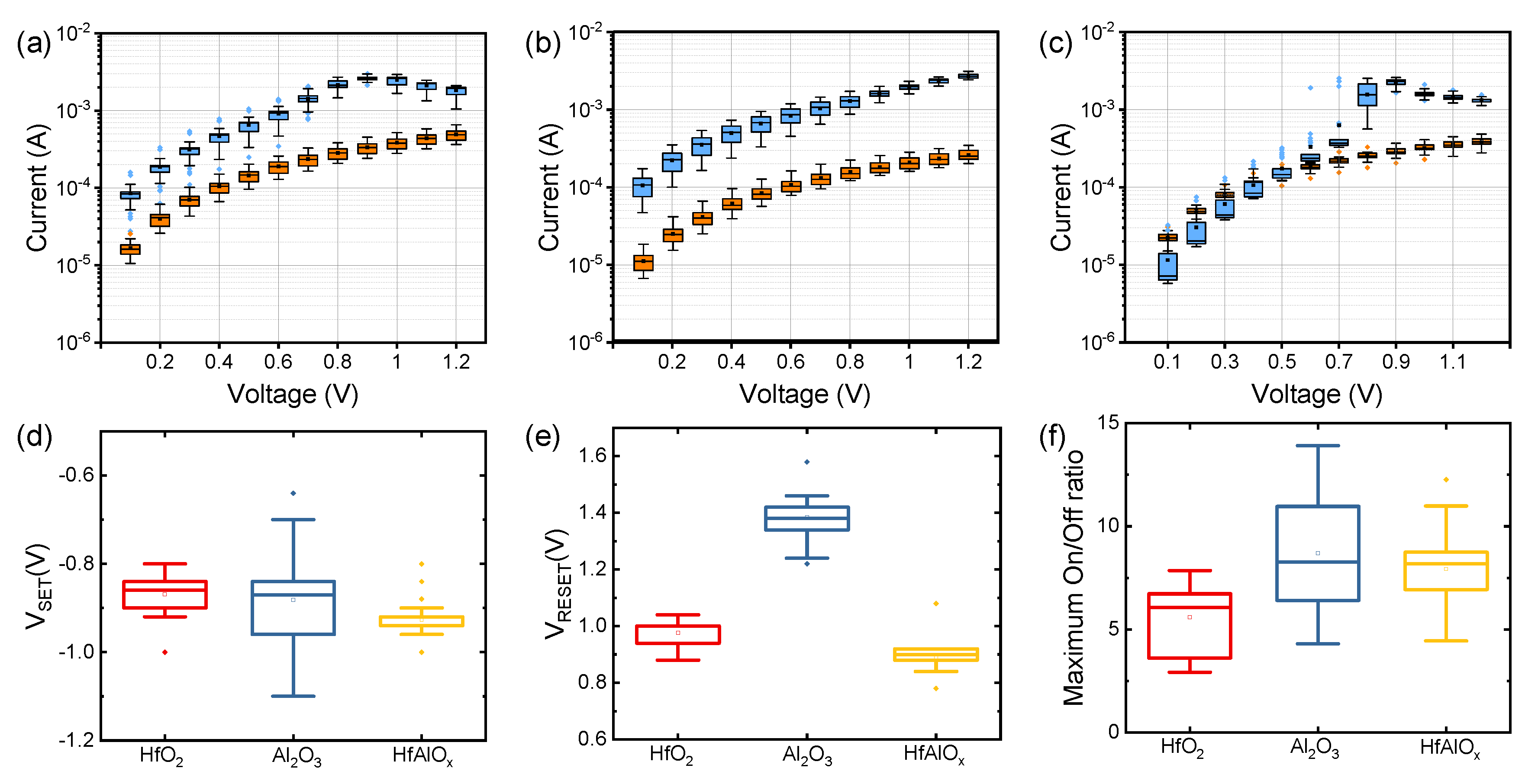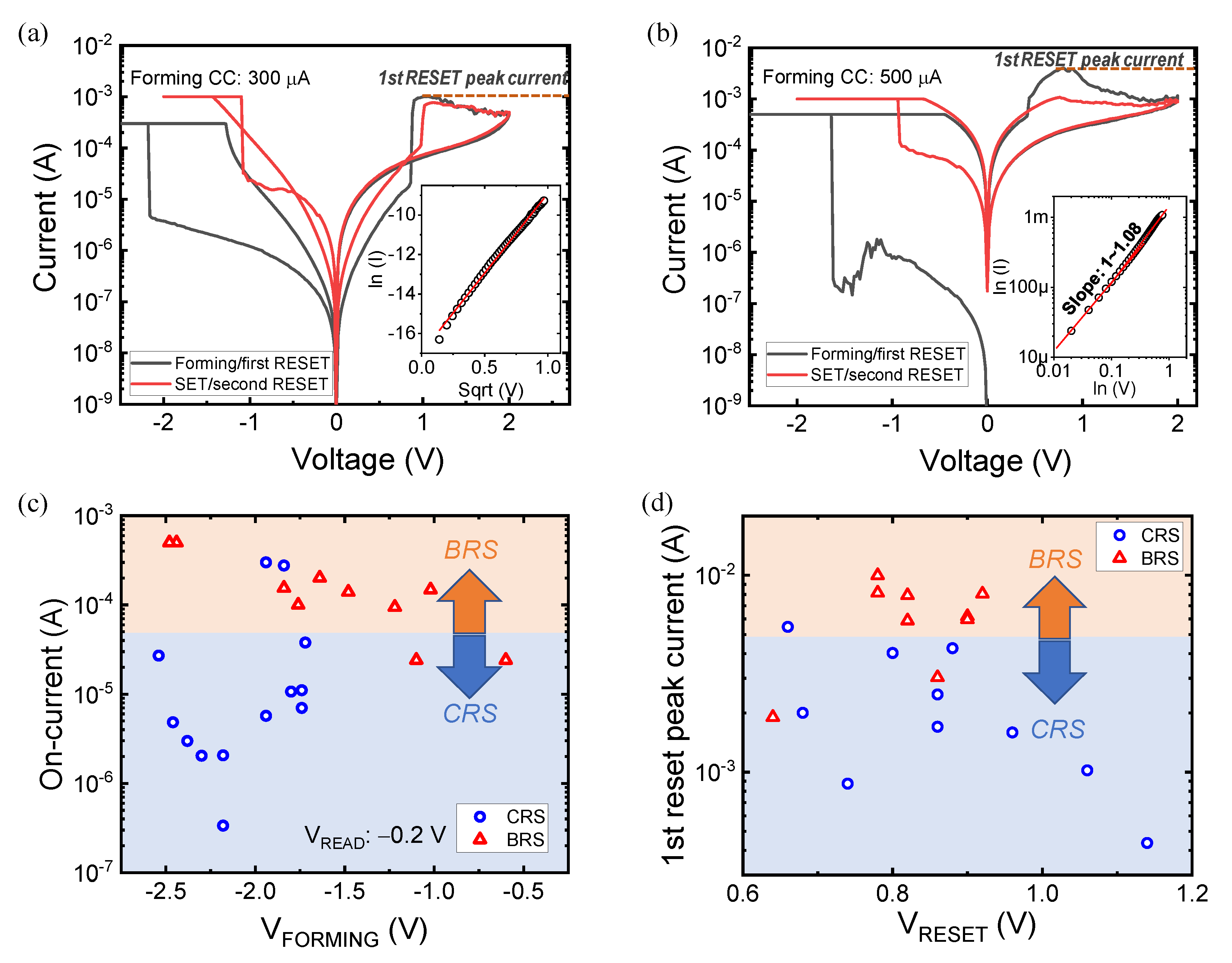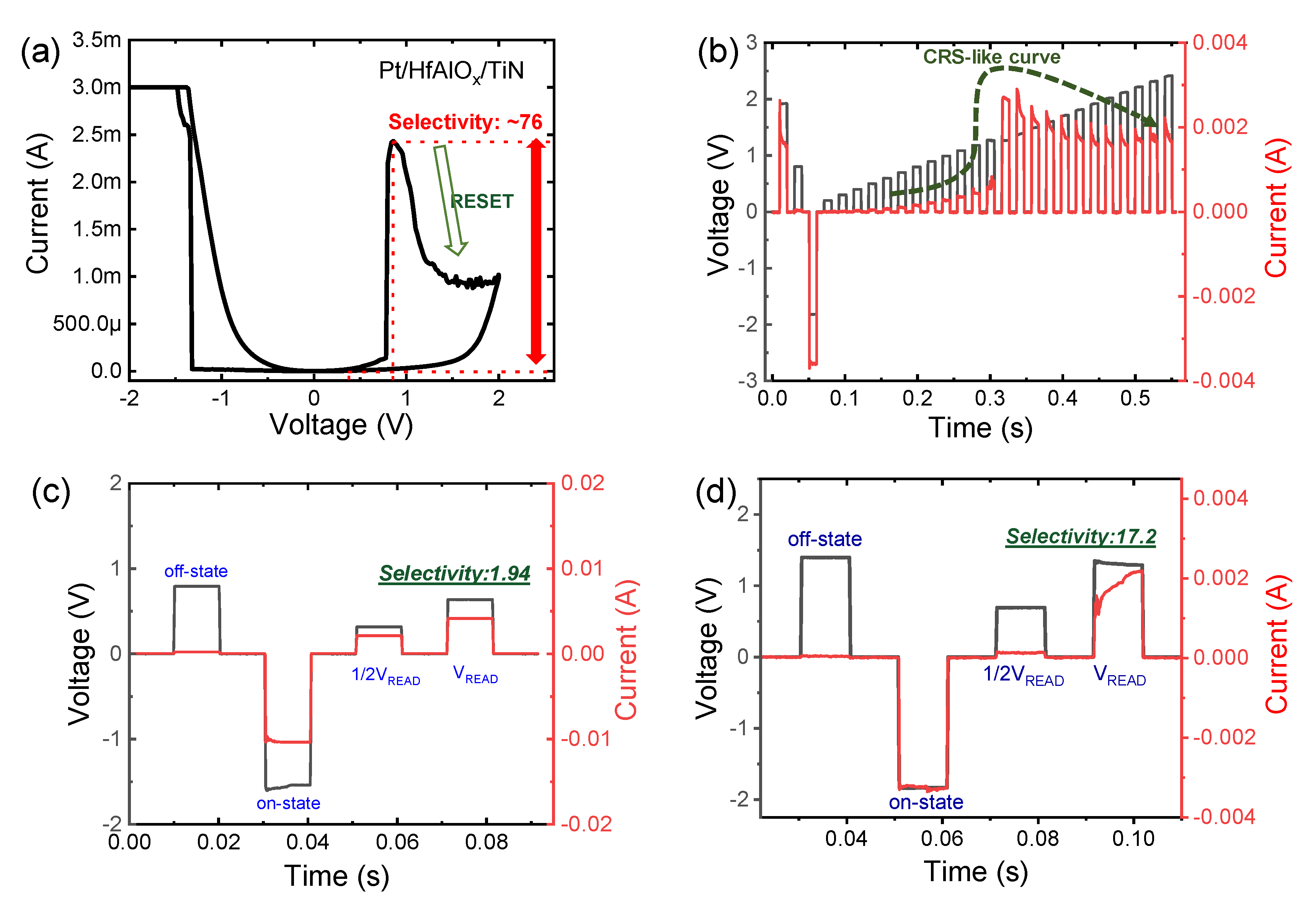Nonlinear Characteristics of Complementary Resistive Switching in HfAlOx-Based Memristor for High-Density Cross-Point Array Structure
Abstract
1. Introduction
2. Experimental Procedure
3. Results and Discussion
4. Conclusions
Author Contributions
Funding
Conflicts of Interest
References
- Waser, R.; Dittmann, R.; Staikov, C.; Szot, K. Redox-based resistive switching memories nanoionic mechanisms, prospects, and challenges. Adv. Mater. 2009, 21, 2632–2663. [Google Scholar] [CrossRef]
- Chang, K.C.; Chang, T.C.; Tsai, T.M.; Zhang, R.; Hung, Y.C.; Syu, Y.E.; Chang, Y.F.; Chen, M.C.; Chu, T.J.; Chen, H.L.; et al. Physical and chemical mechanisms in oxide-based resistance random access memory. Nanoscale Res. Lett. 2015, 10, 120. [Google Scholar] [CrossRef] [PubMed]
- Kim, S.; Jung, S.; Kim, M.H.; Cho, S.; Park, B.G. Resistive switching characteristics of Si3N4-based resistive-switching random-access memory cell with tunnel barrier for high density integration and low-power applications. Appl. Phys. Lett. 2015, 106, 212106. [Google Scholar] [CrossRef]
- Russo, U.; Ielmini, D.; Cagli, C.; Lacaita, A.L. Self-accelerated thermal dissolution model for reset programming in unipolar resistive-switching memory (RRAM) devices. IEEE Trans. Electron Devices 2009, 56, 193–200. [Google Scholar] [CrossRef]
- Larentis, S.; Nardi, F.; Balatti, S.; Gilmer, D.C.; Ielmini, D. Resistive switching by voltage-driven ion migration in bipolar RRAM—Part II: Modeling. IEEE Trans. Electron Devices 2012, 59, 2468–2475. [Google Scholar] [CrossRef]
- Schmelzer, S.; Linn, E.; Böttger, U.; Waser., R. Uniform complementary resistive switching in tantalum oxide using current sweeps. IEEE Electron Devices Lett. 2013, 34, 114–116. [Google Scholar] [CrossRef]
- Kim, S.; Jung, S.; Kim, M.H.; Chen, Y.C.; Chang, Y.F.; Ryoo, K.C.; Cho, S.; Lee, J.H.; Park, B.G. Scaling effect on silicon nitride memristor with highly doped Si substrate. Small 2018, 14, 1704062. [Google Scholar] [CrossRef]
- Yoon, K.J.; Kim, G.H.; Yoo, S.; Bae, W.; Yoon, J.H.; Park, T.H.; Kwon, D.E.; Kwon, Y.J.; Kim, H.J.; Kim, Y.M.; et al. Next-generation memory: Double-layer-stacked one diode-one resistive switching memory crossbar array with an extremely high rectification ratio of 109. Adv. Electron. Mater. 2017, 3, 1700152. [Google Scholar] [CrossRef]
- Yoon, K.J.; Kim, Y.; Hwang, C.S. What will come after V-NAND—Vertical resistive switching memory? Adv. Electron. Mater. 2019, 5, 1800914. [Google Scholar] [CrossRef]
- Yang, X.; Fang, Y.; Yu, Z.; Wang, Z.; Zhang, T.; Yin, M.; Lin, M.; Yang, Y.; Cai, Y.; Huang, R. Nonassociative learning implementation by a single memristor-based multi-terminal synaptic device. Nanoscale 2016, 8, 18897–18904. [Google Scholar] [CrossRef]
- Gao, B.; Bi, Y.; Chen, H.Y.; Liu, R.; Huang, P.; Chen, B.; Liu, L.; Liu, X.; Yu, S.; Wong, H.S.P.; et al. Ultra-low-energy three-dimensional oxide-based electronic synapses for implementation of robust high-accuracy neuromorphic computation systems. ACS Nano 2014, 8, 6998–7004. [Google Scholar] [CrossRef] [PubMed]
- Pan, R.; Li, J.; Zhuge, F.; Zhu, L.; Liang, L.; Zhang, H.; Gao, J.; Cao, H.; Fu, B.; Li, K. Synaptic devices based on purely electronic memristors. Appl. Phys. Lett. 2016, 108, 013504. [Google Scholar] [CrossRef]
- Kim, S.; Kim, H.; Hwang, S.; Kim, M.H.; Chang, Y.F.; Park, B.G. Analog synaptic behavior of a silicon nitride memristor. ACS Appl. Mater. Interfaces 2017, 9, 40420–40427. [Google Scholar] [CrossRef] [PubMed]
- Kim, S.; Chen, J.; Chen, Y.C.; Kim, M.H.; Kim, H.; Kwon, M.W.; Hwang, S.; Ismail, M.; Li, Y.; Miao, X.S.; et al. Neuronal dynamics in HfOx/AlOy-based homeothermic synaptic memristors with low-power and homogeneous resistive switching. Nanoscale 2019, 11, 237. [Google Scholar] [CrossRef] [PubMed]
- Linn, E.; Rosezin, R.; Kügeler, C.; Waser, R. Complementary resistive switches for passive nanocrossbar memories. Nat. Mater. 2010, 9, 403–406. [Google Scholar] [CrossRef]
- Ahn, H.W.; Jeong, D.S.; Cheong, B.K.; Kim, S.D.; Shin, S.Y.; Lim, H.; Kim, D.; Lee, S. A study on the scalability of a selector device using threshold switching in Pt/GeSe/Pt. ECS Solid State Lett. 2013, 2, N31–N33. [Google Scholar] [CrossRef]
- Burr, G.W.; Shenoy, R.S.; Virwani, K.; Narayanan, P.; Padilla, A.; Kurdi, B.; Hwang, H. Access devices for 3D crosspoint memory. J. Vac. Sci. Technol. B Microelectron. Nanometer Struct. 2014, 32, 040802. [Google Scholar] [CrossRef]
- Gao, L.; Chen, P.Y.; Liu, R.; Yu, S. Physical unclonable function exploiting sneak paths in resistive cross-point array. IEEE Trans. Electron. Devices 2016, 63, 3109–3115. [Google Scholar] [CrossRef]
- Jo, S.H.; Kumar, T.; Narayanan, S.; Nazarian, H. Cross-point resistive RAM based on field-assisted superlinear threshold selector. IEEE Trans. Electron Devices 2015, 62, 3477–3481. [Google Scholar] [CrossRef]
- Zhang, L.; Cosemans, S.; Wouters, D.J.; Groeseneken, G.; Jurczak, M.; Govoreanu, B. On the optimal on/off resistance ratio for resistive switching element in one-selector one-resistor crosspoint arrays. IEEE Electron Device Lett. 2015, 36, 570–572. [Google Scholar] [CrossRef]
- Huang, J.J.; Tseng, Y.M.; Hsu, C.W.; Hou, T.H. Bipolar nonlinear Ni/TiO2/Ni selector for 1S1R crossbar array applications. IEEE Electron Device Lett. 2011, 32, 1427–1429. [Google Scholar] [CrossRef]
- Yoon, S.J.; Ryu, J.H.; Ismail, M.; Chen, Y.C.; Chang, Y.F.; Yun, M.J.; Kim, H.D.; Kim, S. Compliance current and temperature effects on non-volatile memory switching and volatile switching dynamics in a Cu/SiOx/p++-Si device. Appl. Phys. Lett. 2019, 115, 212102. [Google Scholar] [CrossRef]
- Song, B.; Xu, H.; Liu, S.; Liu, H.; Liu, Q.; Li, Q. An ovonic threshold switching selector based on Se-rich GeSe chalcogenide. Appl. Phys. A 2019, 772, 125. [Google Scholar] [CrossRef]
- Nirantar, S.; Mayes, E.; Rahman, M.A.; Ahmed, T.; Taha, M.; Bhaskaran, M.; Walia, S.; Sriram, S. In situ nanostructural analysis of volatile threshold switching and non-volatile bipolar resistive switching in mixed-phased a-VOx asymmetric crossbars. Adv. Electron. Mater. 2019, 5, 1900605. [Google Scholar] [CrossRef]
- Shauang, Y.; Hatayama, S.; An, J.; Hong, J.; Ando, D.; Song, Y.; Sutou, Y. Bidirectional selector utilizing hybrid diodes for PCRAM applications. Sci. Rep. 2019, 9, 20209. [Google Scholar] [CrossRef] [PubMed]
- Kim, S.; Cho, S.; Park, B.G. Fully Si compatible SiN resistive switching memory with large self-rectification ratio. AIP Adv. 2016, 6, 015021. [Google Scholar] [CrossRef]
- Kim, S.; Park, B.G. Nonlinear and multilevel resistive switching memory in Ni/Si3N4/Al2O3/TiN structure. Appl. Phys. Lett. 2016, 108, 212103. [Google Scholar] [CrossRef]
- Chen, Y.C.; Lin, C.C.; Hu, S.T.; Lin, C.Y.; Fowler, B.; Lee, J. A novel resistive switching identification method through relaxation characteristics for sneak-path-constrained selectorless RRAM application. Sci. Rep. 2019, 9, 12420. [Google Scholar] [CrossRef]
- Yoon, M.J.; Kim, S.; Kim, S.; Kim, H.D. Memory state protected from leakage current in Ti/SiN/NiN/Pt bilayer resistive random-access memory devices for array applications. Semicond. Sci. Technol. 2019, 34, 075030. [Google Scholar] [CrossRef]
- Kim, H.D.; Yun, M.; Kim, S. Self-rectifying resistive switching behavior observed in Si3N4-based resistive random access memory devices. J. Alloy. Compd. 2015, 651, 340–343. [Google Scholar] [CrossRef]
- Gao, S.; Zeng, F.; Li, F.; Wang, M.; Mao, H.; Wang, G.; Song, C.; Pan, F. Forming-free and self-rectifying resistive switching of the simple Pt/TaOx/n-Si structure for access device-free high-density memory application. Nanoscale 2015, 7, 6031–6038. [Google Scholar] [CrossRef] [PubMed]
- Kau, D.; Tang, S.; Karpov, I.V.; Dodge, R.; Klehn, B.; Kalb, J.A.; Strand, J.; Diaz, A.; Leung, N.; Wu, J.; et al. A stackable cross point phase change memory. In Proceedings of the Technical Digest—International Electron Devices Meeting, Baltimore, MD, USA, 7–9 December 2009. [Google Scholar] [CrossRef]
- Yang, Y.; Sheridan, P.; Lu, W. Complementary resistive switching in tantalum oxide-based resistive memory devices. Appl. Phys. Lett. 2012, 100, 203112. [Google Scholar] [CrossRef]
- Jana, D.; Samanta, S.; Maikap, S.; Cheng, H.M. Evolution of complementary resistive switching characteristics using IrOx/GdOx/Al2O3/TiN structure. Appl. Phys. Lett. 2016, 108, 011605. [Google Scholar] [CrossRef]
- Nardi, F.; Balatti, S.; Larentis, S.; Gilmer, D.C.; Ielmini, D. Complementary switching in oxide-based bipolar resistive-switching random memory. IEEE Trans. Electron Devices 2013, 60, 70–77. [Google Scholar] [CrossRef]
- Chen, X.; Hu, W.; Li, Y.; Wu, S.; Bao, D. Complementary resistive switching behaviors evolved from bipolar TiN/HfO2/Pt device. Appl. Phys. Lett. 2016, 108, 053504. [Google Scholar] [CrossRef]
- Kim, M.H.; Kim, S.; Bang, S.; Kim, T.H.; Lee, D.K.; Cho, S.; Park, B.G. Uniformity improvement of SiNx-based resistive switching memory by suppressed internal overshoot current. IEEE Trans. Nanotechnol. 2018, 17, 824–828. [Google Scholar] [CrossRef]
- Chiang, T.H.; Wager, J.F. Electronic conduction mechanisms in insulators. IEEE Trans. Electron Devices 2018, 65, 223–230. [Google Scholar] [CrossRef]






© 2020 by the authors. Licensee MDPI, Basel, Switzerland. This article is an open access article distributed under the terms and conditions of the Creative Commons Attribution (CC BY) license (http://creativecommons.org/licenses/by/4.0/).
Share and Cite
Choi, J.; Kim, S. Nonlinear Characteristics of Complementary Resistive Switching in HfAlOx-Based Memristor for High-Density Cross-Point Array Structure. Coatings 2020, 10, 765. https://doi.org/10.3390/coatings10080765
Choi J, Kim S. Nonlinear Characteristics of Complementary Resistive Switching in HfAlOx-Based Memristor for High-Density Cross-Point Array Structure. Coatings. 2020; 10(8):765. https://doi.org/10.3390/coatings10080765
Chicago/Turabian StyleChoi, Junhyeok, and Sungjun Kim. 2020. "Nonlinear Characteristics of Complementary Resistive Switching in HfAlOx-Based Memristor for High-Density Cross-Point Array Structure" Coatings 10, no. 8: 765. https://doi.org/10.3390/coatings10080765
APA StyleChoi, J., & Kim, S. (2020). Nonlinear Characteristics of Complementary Resistive Switching in HfAlOx-Based Memristor for High-Density Cross-Point Array Structure. Coatings, 10(8), 765. https://doi.org/10.3390/coatings10080765




